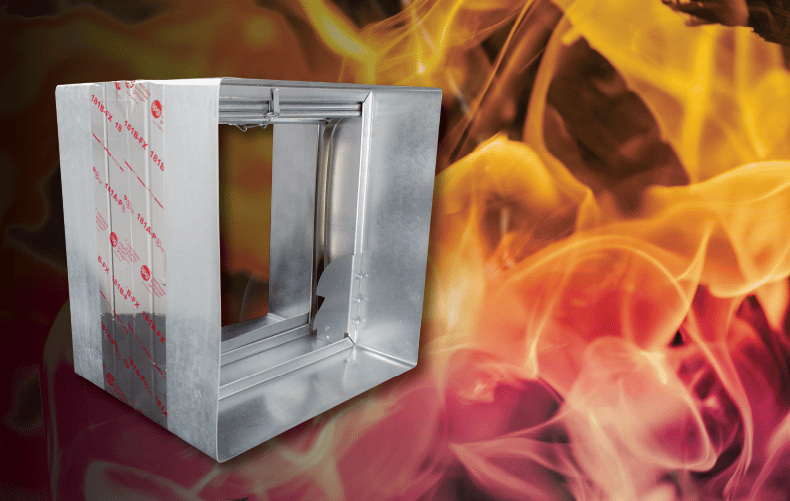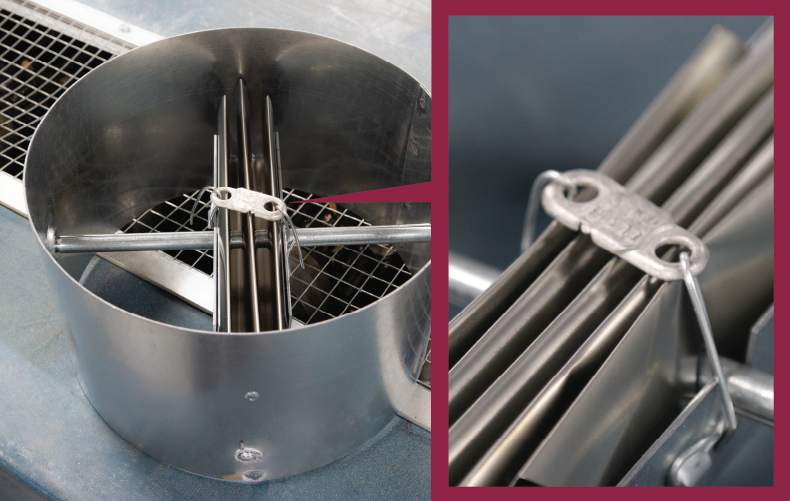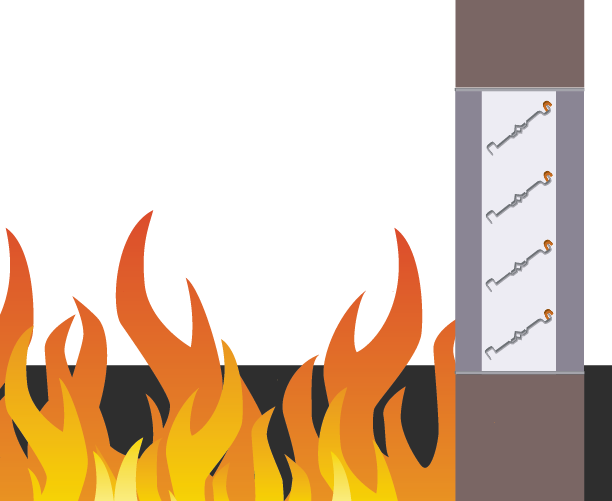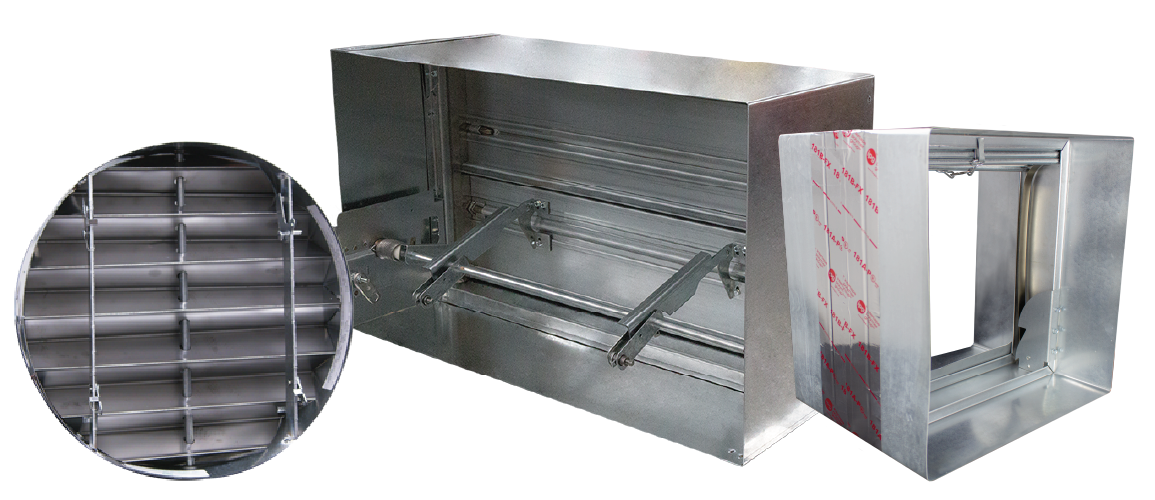What is a fire damper? A fire damper is a damper that closes off penetrations in fire-rated barriers. Learn more about fire dampers in this Newsstand article.
Life Safety in HVAC

HVAC systems will often require several types of dampers to meet the system’s requirements, but not all requirements will involve system performance. There will also be safety requirements that the system must meet.
“Life safety damper” is the common name for dampers that are built and tested to meet these requirements. Life safety dampers include fire dampers, smoke dampers, combination fire-smoke dampers, and ceiling radiation dampers.
These dampers will be required at key points throughout the building, to slow the spread of fire and smoke. Your HVAC system must be prepared for an emergency.
What is a Fire Damper?
A fire damper is a life safety damper built and tested to hinder the spread of flames. Fire barriers have fire dampers installed where ductwork or a ventilation opening passes through. These points penetrate the barrier, creating openings that allow flames to pass from one side to the other. These openings are penetrations in the fire barrier.

Fire dampers are designed and tested to withstand intense heat.
Therefore, building codes will require fire dampers at these barrier penetrations to hinder the spread of fire through the penetrations in the fire barrier.
Fire Dampers and Heat Response Devices (HRDs)
Standard control dampers open and close throughout the day to keep air moving through the ductwork, but fire dampers stay open until a need arises. Fire dampers close automatically when a fire event occurs. They do this with help from a heat response device, or HRD.
Heat response devices are temperature sensitive mechanisms designed to activate under intense heat. Fusible links melt under intense heat, while thermo discs expand as temperatures rise. These devices provide the means to react to a fire event.

Pictured: The fusible link holds the curtain blade in place. When it melts, the link will break apart and release the blade.
The exact activation method will differ based on the HRD used for the damper. Fusible links are the most common heat response device. The damper's blades directly connect to the fusible link, which breaks apart at elevated temperatures.
When broken, the link releases the blades from their fully open position. The blades return to the closed position, either by falling into place or through spring driven motion.
Thermo discs are HRDs incorporated into the circuitry of an electric actuator. The discs are part of the electrical circuit. These discs expand when exposed to elevated temperatures. When this happens, the thermo disc breaks the electrical circuit, cutting off power to the actuator. With no power, the actuator will close the damper by utilizing internal springs. We call this action "power open, spring closed".
The key is response time. Fire dampers must close the moment a fire breaks out. Once closed, the damper will remain closed to hinder the spread of flames through the penetration. They will only reopen when operated by a technician once the fire event has ended.
Technicians will assess the damper's reusability in the barrier, but fire dampers are commonly replaced to ensure excellent condition.
Testing Fire Dampers
UL-approved laboratories must rigorously test fire dampers and ensure adherence to stringent codes before approving them for fire barriers. Fire endurance testing is just one of several tests that a fire damper must complete for a fire-resistance rating.
Following the manufacturer's instructions, testers install the damper in the test oven opening for this test. They set the fire damper to fully open and set the damper’s heat response device. Fusible links are the most common heat response devices because they are cheap and easy to replace.
Then, the test oven is engaged, and the fire damper will close in reaction to the elevated heat.

The fire damper must remain closed until the end of the test. Depending on the intended rating, the fire endurance test will run for 90 minutes (1.5 hours) or 180 minutes (3 hours), with temperatures reaching over 1700 degrees Fahrenheit. The damper must not fail or allow flames past the damper. This testing ensures that the damper remains intact and keeps the penetration covered during a fire.
After the fire endurance test, the damper will undergo additional testing, including duct impact testing. Duct impact tests verify that the fire damper stays in the barrier even if falling debris compromises the connected ductwork.
Once the fire damper has passed all these tests, the damper model will receive a fire resistance rating according to the fire endurance test completed: either 1.5 hours or 3 hours of fire resistance.
The Purpose of Fire Dampers
The purpose of fire dampers is to cover the penetrations found in fire-rated barriers, which compartmentalize a building during a fire event. As part of a fire-rated assembly, fire dampers can help occupants when a fire breaks out by hindering the passage of flames through the penetrations in the barrier.
Passive fire protection, like fire dampers and other life safety dampers, are in place for occupants to safely evacuate the building.

There are several fire damper types for various applications, but they all serve the same purpose: passive fire protection.
Looking to add fire dampers to your next project? Contact Air Balance today. We build static and dynamic fire dampers to fit your needs. Trust a brand with over 50 years of experience in meeting NFPA and UL requirements for fire safety in HVAC. Start your next project with life safety dampers built for the task.
Passive fire protection is an important aspect of any project. What is your experience with life safety dampers? Tell us in the comments section. We want to know!
Learn more about dampers and HVAC equipment with these Newsstand articles:
- The Four Types of UL Life Safety Dampers
- Five Types of Dampers and When to Use Them
- Five Specialty Dampers for HVAC Design
.webp?width=91&height=70&name=MCDLG%20Logo%20(Resize).webp)
.webp)




